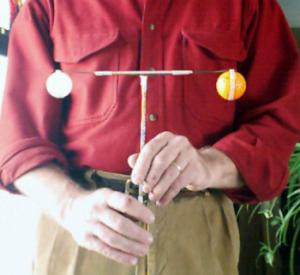
This is about estimating the weight of something really big, if you can handle only a small
sample of it.
(Apologies to the purists for freely mixing up mass and weight in what follows).
I started with an example a little closer to home: in the ceiling of the school's
lobby there are these giant exposed wood beams.
(I actually handled every one of them myself).
How would you figure out the weight of these beams? I introduced the idea of
density, the weight per unit volume of a material.
I still had a block of wood that had
been cut off one of the beams, and we measured it (6cm × 25cm × 25cm), and weighed
it on my kitchen scale (1650 g) .
The density then is: weight 1650 g
density = -------- = --------- = 0.44 g/cm3
volume 3750 cm3
Then we calculated the volume of the beams, which were 12"×12"×22' or
30cm × 30cm × 700cm = 630000 cm3.
Each one of these cm3 weighs 0.44 grams, so the whole beam weighs
630000 × 0.44 = 277000 grams, or 277 kilos, or 600 lbs. (In 1997, the wood
was much greener, and the beams weighed more than 800 lbs each).
You can see we did lots of unit conversions, which takes some patience in 6th grade. To
give them a feeling of what grams an kilograms are in real life, I had brought my
standard 1-gram weight (a dollar bill), and 1-liter bottle of water (=1 kilogram).
Now we did the same for the earth. The core of the earth consists of iron, and
the outer crust is of course mostly rock. In between is the mantle, composed of molten rock.
Using the same procedure as with the wood block, we measured the density of a slab of
iron I had brought in, and of rock (a chunk of local
sandstone). The density of iron came in at 5.7 g/cm3, and the density of
the stone was about 2.7 g/cm3. So the average density of the Earth is somewhere
between 2.7 and 5.7. Since the crust only makes up a small portion, and there is compression
of material as you go deeper and deeper down, it turns out that for the whole Earth the
average density is
about 5.5 g/cm3: our tabletop measurements were in the right ballpark.
Next, we needed to find out the volume of the Earth. Luckily, the kids in this class
knew the story of Eratosthenes of Alexandria. I was impressed!
Eratosthenes had figured out the circumference of the Earth (see the links below),
and got the answer correct at about 40000 km. That means the diameter is 12000 km. What
is the volume of a sphere if you know the diameter? I used the approximation that it is
about half of the volume of a cube that just fits around the sphere.
 We were starting to deal with too many zeros, so I showed how to write the number of zeros in
scientific notation. So the diameter of the Earth was now written as
12×103 km, or
We were starting to deal with too many zeros, so I showed how to write the number of zeros in
scientific notation. So the diameter of the Earth was now written as
12×103 km, or
12×106 m, or
12×108 cm.
The volume of a cube that size is
12×12×12×1024 cm3, and the volume
of the Earth is half that, or 850×1024 cm3.
Weight is volume times density, so
Weight of the Earth = 850×5.5×1024 grams, or
4675×1024 g, or
4.7×1024 kg, or
10×1024 lbs
As a final touch, does a number with 24 zeros have a name? Starting with our knowledge
of millions and billions, we made the following table:
| number | latin
word | name | number of zeros |
| 1 | mono.. | million | 6 |
| 2 | bi.. | billion | 9 |
| 3 | tri.. | trillion | 12 |
| 4 | quatr.. | quadrillion | 15 |
| 5 | quint.. | quintillion | 18 |
| 6 | sext.. | sextillion | 21 |
| 7 | sept.. | septillion | 24 |
| 8 | oct.. | octillion | 27 |
Therefore the approximate weight of the Earth is ten septillion pounds.
Links about the size, shape and weight of the Earth:
|




 Same thing, but now with a pingpong ball taped on. Again, if I take a quick
step forward, the pingpong ball will swing towards my chest. If I want to prevent this by
gripping the vertical part of the coathanger, it will be easier than trying to do this with
the golfball.
Same thing, but now with a pingpong ball taped on. Again, if I take a quick
step forward, the pingpong ball will swing towards my chest. If I want to prevent this by
gripping the vertical part of the coathanger, it will be easier than trying to do this with
the golfball.
 Now I connect the two. What will happen when I step forward now? Since the golfball
is much heavier than th epinpong ball, the golfball 'wins': the golfball will go towards
my chest, and the pingpong ball will be forced forwards.
Now I connect the two. What will happen when I step forward now? Since the golfball
is much heavier than th epinpong ball, the golfball 'wins': the golfball will go towards
my chest, and the pingpong ball will be forced forwards.

 (More to come...)
(More to come...)

 We were starting to deal with too many zeros, so I showed how to write the number of zeros in
scientific notation. So the diameter of the Earth was now written as
We were starting to deal with too many zeros, so I showed how to write the number of zeros in
scientific notation. So the diameter of the Earth was now written as